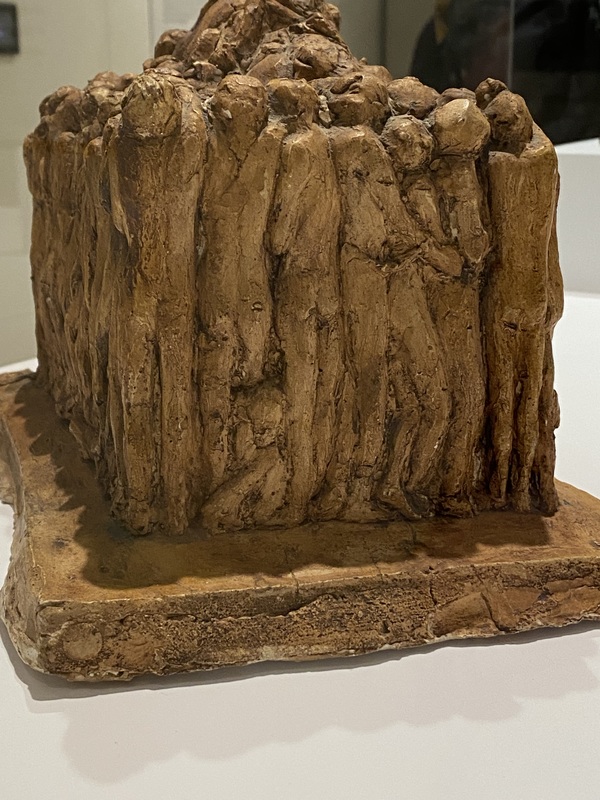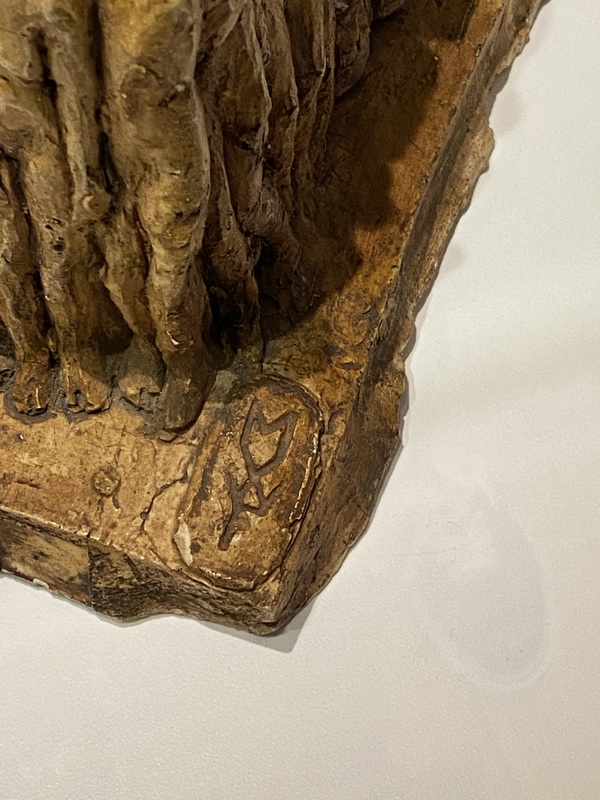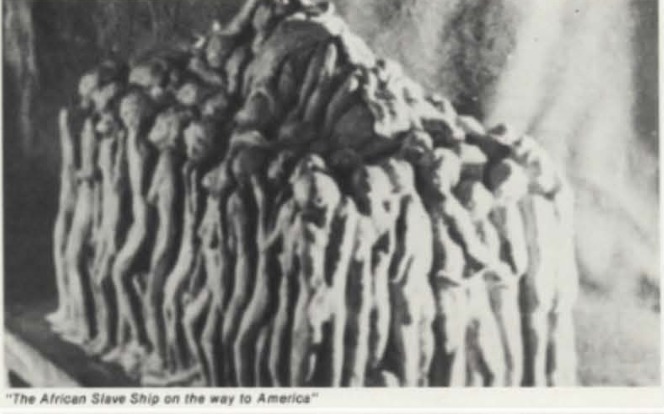The Slave Ship
Item
Artist
Meta Vaux Warrick Fuller
Title
The Slave Ship
Date
before 1954
Medium
painted plaster
Accession Number
Slave Ship
Label
Slave Ship depicts a cluster of enslaved individuals aboard a slave ship with ghastly faces, evoking a sense of suffocation and distress. Each figure has a similar expression of horror; their mouths are open; and their bodies are emaciated. These elements of despair are especially seen in the figure on top, whose body is pushing out from the rest of the individuals on the ship.
The gender and age of each figure is unclear, as there are no distinguishable genitalia or other features to determine gender and age. However, a child who kneels in the back of the piece represents the many children who were forcibly brought to the West Indies, the United States, and Europe as part of the Trans-Atlantic slave trade.
Although there is no ship present, the title tells us that it is a slave ship, and the rectangular shape of the sculpture is reminiscent of the crammed environment in which the enslaved endured on ships. Enslaved individuals would have been perceived as a commodity and treated as such which is visually emphasized in this artwork through the inhumane conditions Fuller recreated.
The sculpture is created from painted plaster; a medium in which plaster is created into a mold which is removed, and fresh liquid plaster is poured into, creating a copy of the original. The Danforth Museum owns the original mold.
Fuller was active in politics and was aware of the rising tensions that accompanied the Civil Rights Movement (1954 – 1968) as well as the long-term impacts of slavery within the United States. In response to the 1918 lynching of Mary Turner, Fuller created a piece that served as a memorial in 1919, titled Mary Turner: A Silent Protest Against Mob Violence, also made of painted plaster. Fuller’s artistic career is full of similar Symbolist artworks that represent her experience as an African American woman, as well as the experiences of Africans throughout history. Slave Ship makes us wonder – How can we reconcile with our past? How do we memorialize enslaved individuals?
Abigayle Versackas
ARTH 282
April 18, 2023
The gender and age of each figure is unclear, as there are no distinguishable genitalia or other features to determine gender and age. However, a child who kneels in the back of the piece represents the many children who were forcibly brought to the West Indies, the United States, and Europe as part of the Trans-Atlantic slave trade.
Although there is no ship present, the title tells us that it is a slave ship, and the rectangular shape of the sculpture is reminiscent of the crammed environment in which the enslaved endured on ships. Enslaved individuals would have been perceived as a commodity and treated as such which is visually emphasized in this artwork through the inhumane conditions Fuller recreated.
The sculpture is created from painted plaster; a medium in which plaster is created into a mold which is removed, and fresh liquid plaster is poured into, creating a copy of the original. The Danforth Museum owns the original mold.
Fuller was active in politics and was aware of the rising tensions that accompanied the Civil Rights Movement (1954 – 1968) as well as the long-term impacts of slavery within the United States. In response to the 1918 lynching of Mary Turner, Fuller created a piece that served as a memorial in 1919, titled Mary Turner: A Silent Protest Against Mob Violence, also made of painted plaster. Fuller’s artistic career is full of similar Symbolist artworks that represent her experience as an African American woman, as well as the experiences of Africans throughout history. Slave Ship makes us wonder – How can we reconcile with our past? How do we memorialize enslaved individuals?
Abigayle Versackas
ARTH 282
April 18, 2023
Accrual Method
on loan to Danforth Art Museum
Provenance
private collection
Tombstone
Meta Vaux Warrick Fuller (1877-1968)
The Slave Ship, c. 1954
Painted plaster, 8" x 11.5" x 7.75"
The Slave Ship, c. 1954
Painted plaster, 8" x 11.5" x 7.75"



